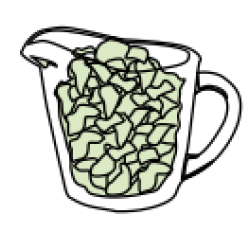Source Institutions
Source Institutions
Add to list Go to activity
Activity link broken? See if it's at the internet archive

In this nutrition and estimation activity (page 12 of PDF), learners estimate serving sizes of different foods and compare their estimates to serving size information provided on nutrition food labels. A Quick Hand Measures guide helps learners visualize serving sizes of different foods using their hand (i.e. a closed fist = serving size of a piece of fruit). This activity also introduces learners to solid and liquid measures. This guide includes background information, setup and management tips, extensions, reliable resource links and handouts.
- 10 to 30 minutes
- 45 to 60 minutes
- $5 - $10 per group of students
- Ages 8 - 14
- Activity, Lesson/Lesson Plan
- English
Quick Guide
Materials List (per group of students)
- 3 large containers for dry sample foods
- 2-liter bottle of regular soft drink
- 2 identical packages of each of the following: frozen peas, dry breakfast cereal, popped popcorn
- 6 paper plates (for dry foods)
- 2 large cups or containers (for liquids)
- 2 measuring cups (one for solids, one for liquids)
- Permanent marker
- Copy of What is a Serving Size? sheet (p. 14)
- Prepared copy of Nutrition Facts Labels page (see Setup)
- 4 copies of Estimates and Labels sheet (p. 15)
Subjects
-
Life Sciences
-
Human Body
- Health and Nutrition
-
Human Body
-
Mathematics
-
Data Analysis and Probability
- Data Analysis
- Data Collection
- Data Representation
-
Measurement
- Units of Measurement
- Size and Scale
- Number and Operations
- Reasoning and Proof
- Representation
-
Data Analysis and Probability
-
The Nature of Technology
-
The Design Process
- Problem Solving
-
The Design Process
-
The Nature of Science
-
The Scientific Process
- Conducting Investigations
- Gathering Data
- Formulating Explanations
- Communicating Results
-
The Scientific Process
Informal Categories
- Food and Cooking
Audience
To use this activity, learners need to:
- see
- read
- touch
Learning styles supported:
- Involves teamwork and communication skills
- Involves hands-on or lab activities
Other
Includes alignment to state and/or national standards:
This resource is part of:
Access Rights:
- Free access
By:
- Moreno, Nancy P. ; Clayton, Sonia Rahmati ; Cutler, Paula H. ; Young, Martha S. ; Tharp, Barbara Z.
Rights:
- All rights reserved, Baylor College of Medicine, 2009
Funding Source:
- NASA, NCC9-58
